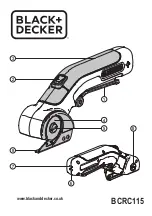
6
ENGLISH
(Original instructions)
u
Make sure that the cord is located so that it will not
be stepped on, tripped over or otherwise subjected to
damage or stress.
u
When charging the tool outdoors, always provide a dry
location.
u
DO NOT use a charging cable with a damaged cord or
plugs. Have them replaced immediately.
u
Foreign materials of a conductive nature, such as, but not
limited to, grinding dust, metal chips, steel wool, aluminum
foil or any buildup of metallic particles should be kept
away from the charging and micro charging plugs and
port.
u
Always unplug the charging cable from the power supply
when there is no tool attached to it.
Features
This appliance includes some or all of the following features:
1. Trigger
2. Lock out button
3. Handle
4. Blade
5. Blade bolt
6. Charge port
7. Charging LEDs
8. Spindle lock
9. Shoe
10. Charge lead
Assembly
Warning!
To reduce the risk of serious personal injury, turn
unit off and keep away from the on-off button before making
any adjustments or removing/installing attachments or
accessories. An accidental start‑up can cause injury.
Charging procedure (fig. A)
Warning!
Do not use tool while it is connected to the charger.
u
Insert the charging plug (10) into the charge port (6).
u
Plug the charging plug into any charging port (such as on
a computer).
u
There are 3 LEDs which flash in sequence
The green charging LEDs 7 will flash.
One will flash with a low charge.
Two will flash with a medium charge .
Three will flash with a high charge.
All LEDs will remain on when tool is fully charged.
u
Battery can be left charging or charger can be
disconnnected.
Important charging notes
u
The charger and tool may become warm to the touch
while charging.
This is a normal condition, and does not indicate a
problem.
Never tape the switch in the ON position.
u
DO NOT incinerate the tool even if it is severely damaged
or is completely worn out. The battery can explode
in a fire. Toxic fumes and materials are created when
lithium-ion batteries are burned.
u
If battery contents come into contact with the skin,
immediately wash area with mild soap and water. If battery
liquid gets into the eye, rinse water over the open eye for
15 minutes or until irritation ceases. If medical attention is
needed, the battery electrolyte is composed of a mixture
of liquid organic carbonates and lithium salts.
u
Contents of opened battery cells may cause respiratory
irritation. Provide fresh air. If symptoms persist, seek
medical attention.
u
Battery liquid may be flammable if exposed to spark or
flame.
u
Never attempt to open the tool for any reason. If the tool
case is cracked or damaged, do not charge. Do not crush,
drop or damage the tool. Do not use a tool or charger that
has received a sharp blow, been dropped, run over or
damaged in any way (e.g., pierced with a nail, hit with a
hammer, stepped on). Damaged tools should be returned
to the service center for recycling.
Storage recommendations
The best storage place is one that is cool and dry, away from
direct sunlight and excess heat or cold.
Store the fully charged tool disconnected from the charger.
Transportation
Note:
Integral Li-ion tools should not be put in checked
baggage on airplanes and must be properly protected from
short circuits if they are in carry-on baggage.
Important safety instructions for all integral battery
charging
Warning!
Read all safety warnings, instructions, and
cautionary markings for the battery, charging cable and
product. Failure to follow the warnings and instructions may
result in electric shock, fire and/or serious injury.
u
The provided charging cable is not intended for any uses
other than charging BLACK+DECKER rechargeable tools
with micro charging ports.
Charging other types of tools may cause their batteries to
overheat and burst, resulting in personal injury, property
damage, fire, electric shock or electrocution.
u
Use only with the Listed/Certified Information Technology
(computer) Equipment.
u
DO NOT expose charging cable to water, rain or snow.
u
Pull by the plugs rather than the cord when disconnecting
the charging cable. This will reduce the risk of damage to
the plugs and cord.







































